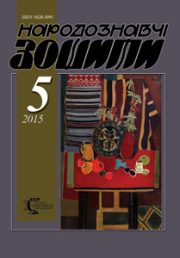The Ethnology Notebooks. 2022. № 3 (165), 525—535
UDK 7.01:[75.077.038.4:159.955.2]”19/20″
DOI https://doi.org/10.15407/nz2022.03.525
«NAIVE ART»: EMERGING OF THE CONCEPT AND DIFFERENT NAMES OF THE PHENOMENA
SELIVATCHOV Mykhailo
- ORCID ID: http://orcid.org/0000-0001-9199-0270
- Doctor of Art History, Professor,
- Art Theory and History Department
- in the National Academy of Fine Art and Architecture,
- 20, Voznesensky uzviz, 04053, Kyiv, Ukraine,
- Contacts: e-mail: mik_sel@ukr.net
Abstract. The actuality of the article is due to the modern parallel distribution in the 20th century multilingual professional literature of several dozen related variants of names, which gradually replaced the long-used concept of «primitive art».
The aim of the article is to clarify the origin and systematize new terms relevant to «naive art», to identify among them both synonyms and non-identical definitions related to certain features or aspects of perception of the denoted phenomena and concepts.
The method of work provided for the establishment of chronology, etymology and actual content of such terminological tokens, their conventional classification on the basis of a number of «taxons»:
1) level and method of teaching (amateurish art, autodidactic, unprofessional, primitive, provincial, self-taught and so on);
2) attitude to the dominant direction of culture (art-brut, grassroots, innocent art, instinctive, marginal, primitive, vulgar, wild art, outsiders etc.);
3) attitude to the tastes of a particular society or tradition (source art, folk, peasant, popular, mass, urban, bourgeois, native etc.).
As a result of the study, we concluded that the phrases «naive art» and numerous analogues discussed in the article refer to a wide range of dissimilar phenomena, the main common feature of which is the lack of academic training and the predominance of personal authorship, not burdened by sociocultural tradition. The latter distinguishes «naive art» from «folk». Relevant conceptual nominations do not constitute a hierarchy of types, but only parallel series of synonymous names, which are due to various motives, including commercial and political.
In general, the terminology of art is formed in individual languages, countries and each historical period in a unique way, by chance, becomes the subject of constant debate. Unlike the natural sciences, art definitions do not correspond to real phenomena, but to changing perceptions of them, and terminological tokens are rooted in this field not because of their logic and correctness, but mainly because they are lucky to accurately, wittily and sonorously «lie on the tongue» at the right time.
Keywords: concepts, nominations, notions, terms, polynomic, synonyms.
Received 2.04.2022
REFERENCES
- Selivatchov, M. (Ed.). (1996). Ukrainian folk art in the concepts of international terminology (primitive, folklore, amateurism, naive, kitsch…): Collective research on the materials of the Second Honchar readings. Kyiv: Ivan Honchar Museum; Rodovid [in Ukrainian].
- Bakhtin, M. (2010). Collect. op.: in 7 vol. (Vol. 4 (2). Creativity of Francois Rabelais and folk culture of the Middle Ages and the Renaissance. Rabelais and Gogol (The art of words and folk culture of laughter). Moscow: Languages of Slavic Culture [in Russian].
- Otkovych, V. (1990). Folk current in Ukrainian painting of XVII—XVIII centuries. Kyiv: Naukova dumka [in Ukrainian].
- Popova, L. (1885). Folk icon painting of Ukraine of the 19th century. Author’s Cand. art history dissertation abstract. Leningrad [in Russian].
- Tananaeva, L., & Prokofiev, V.N. (Ed.). (1983). On grassroots forms in the art of Eastern Europe in the Baroque era of the XVII—XVIII centuries. Primitive and its place in the artistic culture of modern and contemporary times. Moscow: Nauka [in Russian].
- Tin, M.B. (2007). The first forms. The abstract design language of folk art. Oslo: Novus publishing house; Department of Comparative Cultural Research [in Norwegian and English].
- Bessonova, M., & Prokofiev, V.N. (Ed.). (1983). Henri Rousseau and French naives. Primitive and its place in the artistic culture of the new and modern times (P. 133—159). Moscow [in Russian].
- Jakovsky, Anatole. (1973). The Proverbs seen by the Naive Painters. Published by Editions Max Fourny, Paris [in French].
- Bihali-Merin, O. (Ed.). (1959). Art of the Yugoslavian primitivists. Belgrade: Yugoslavia [in Russian].
- Bihalji-Merin, O. (1984). World Encyclopedia of Naive Art: A Hundred Years of Naive Art. University of California.
- Huyghe, R. (Ed.). (1965). Larousse Encyclopedia of Modern Art. New York: Prometheus press.
- Museum of Naive and Marginal Art (Yagodina). Serbia and Montenegro / Central Serbia / Jagodina / Yagodina / Boska Duricica, for free access: Retrieved from: https://wikimapia.org/15709011/ru/%D0%9C%D1%83%D0%B7%D0%B5%D0%B9-%D0%BD%D0%B0%D0%B8% D0% B2% D0% BD% D0% BE% D0% B3% D0% BE-% D0% B8-% D0% BC% D0% B0% D1% 80% D0% B3% D0% B8% D0% BD% D0% B0% D0% BB% D1% 8C% D0% BD% D0% BE% D0% B3% D0% BE-% D0% B8% D1% 81% D0% BA% D1% 83% D1% 81% D1 % 81% D1% 82% D0% B2% D0% B0 (as of 10/25/2020) [in Russian].
- (1994). The International Exhibition of Naive Art INSITA’94. Bratislava: Slovac National Gallery [in Slovak, German and English].
- Polsky, A. Housing and communal art. Institute for Street Art Research; available at: Retrieved from: http://streetartinitute.com/communal-art (last assess 10/25/2020) [in Russian].
- Polsky, A. (2017). Informal ethics of street art. Art magazine, 102, 144—153 [in Russian].
- Bohemskaya, K. (2001). Understand the primitive. Amateur, naive and outsider art in the 20th century. St. Petersburg: Aleteya [in Russian].
- Bohemskaya, K. (Ed.) (1992). Primitive in art: the edges of the problem. Moscow: RII [in Russian].
- Marra, A. (2004). Outsider Art: The Art of the Insane. In David, J. Bromley VCU Honor Program. Modern Influences in Contemporary Art. 2004 season.
- Carrier, D., & Pissarro, J. (2013). Wild Art. New York; London: Faeidon.
- Kuspit, D. (1991). The appropriation of Marginal Art in the 1989s. American Art, 1/2 (Winter-Spring) (Vol. 5, pp. 132—141).
- Walker, J.A. (1992). Naive Art (also Innocent Art, Peintres Naifs, Primitive Art). Walker’s Glossary of Art, Architecture and Design since 1945.
- Reitman, F. (1950). Psychotic Art. Psychology Press.
- MacGregor, J.M. (1989). The Discovery of Art of the Insane. Princeton University Press.
- Vlasov, V. (2004—2009). Articles about inzit, naive art, primitives etcetera in his ten-volume «New Encyclopedic Dictionary of Fine Arts». St. Petersburg: Classics [in Russian].
- Lebedeva, A. (2018). Artistic construction, technical aesthetics, design: the terms are not disputed — they are agreed. Art of Ukraine of the first half of the XX century in the global context: coll. abstracts of reports of international scientific conf., Kyiv, April 11, 2018. Kyiv: NAMU [in Ukrainian].
- Lozhkina, Alisa. (Ed.). (2020). Space inside. Naive and art of outsiders in Ukraine and the world: definitions, historical context, research cases. Proceedings of the online conference within the Festival of Naive Art. Kyiv: Artbook Publishing House [in Ukrainian].







